| Srl | Item |
| 1 |
ID:
131324


|
|
|
|
|
| Publication |
2014.
|
| Summary/Abstract |
After long being a continental power, China in the 21st century has started to follow an ambitious maritime expansion course, seeking to bolster its power-projection capabilities, especially n North Asia, South-east Asia, the South-west Pacific and the South Pacific. This has pushed the countries in the Asia-Pacific region such as Australia, India, Vietnam, Philippines and Indonesia to form an effective strategic partnership. Further, it has induced the United States to increase its maritime military presence in the region--with a view to having a forward presence or pivot. It has sought increased strategic co-operation and alliance with countries that are wary of China's expanding maritime presence.
|
|
|
|
|
|
|
|
|
|
|
|
|
|
|
|
| 2 |
ID:
109876


|
|
|
|
|
| Publication |
2012.
|
| Summary/Abstract |
This article examines the extent of the so-called 'civil nuclear renaissance' and the danger it poses to the integrity of the international non-proliferation regime. It also explores the drivers behind the resurgent interest in nuclear energy, as well as the arguments against increased reliance on nuclear power. The article argues that growing interest in the peaceful uses of nuclear energy - even when tempered by strong safety, environmental, economic and security concerns - poses a real challenge to global non-proliferation objectives, a challenge exacerbated by the contradiction at the heart of the non-proliferation treaty architecture. However, the article does not accept the view that civil nuclear capability will inexorably lead to proliferation. Rather, it finds that motive is as central as capability in determining the likelihood of proliferation, and highlights the difficulties of safeguarding against future intentions. Following a brief discussion of the Southeast Asian and North Asian contexts, the paper concludes with a short discussion of how proliferation risks stemming from an increase in nuclear energy might be mitigated.
|
|
|
|
|
|
|
|
|
|
|
|
|
|
|
|